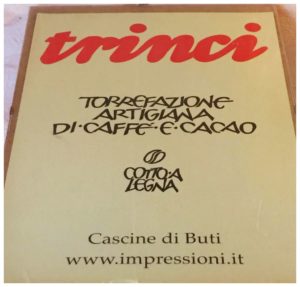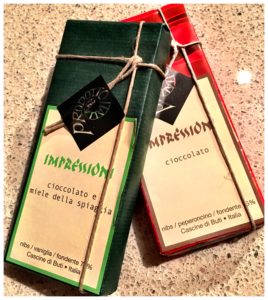16 July 2016
The art of chocolate making is considered sacred, by many. Well documented in the annals of time, from books and encyclopedias to the more contemporary e-books and web articles.
Have you ever wondered what happens when an important step is removed from the manufacturing process?
Hubby and I sought to find out as we went in search of this next Tuscan chocolate maker. Hailing from a coffee roasting family, this individual spent many years perfecting the art of roasting and even consulted in this trade. A chance meeting and casual suggestion led him to broaden his horizons, to experiment with chocolate. He did away with the all important conching process, choosing instead to mix ground cocoa nibs with cocoa butter and cane sugar, to create a chocolate paste. His technique has since been refined and this paste now forms the working base for his artisan chocolate bars, Trinci.
 The search for Trinci resulted in hubby and I arriving at the gated entrance to a factory, in a secluded industrial estate in Cascine de Buti, on a cool and rainy Tuscan summer’s day. We were expecting a shop or cafe! Instead, we are greeted by a lone cat. Disappointed and with no help from the website, which is mainly in Italian, I am ready to give up and move on. However, hubby persists and decides to step out of the car to buzz the intercom. Out comes a lady in white uniform. From the passenger seat of the car, I can tell that hubby is struggling to communicate with her. She goes back into the factory, emerging moments later with a small bit of paper. On it is scrawled a name of a shop and a town. Apparently, Trinci’s chocolates can only be purchased in 3 locations, one of which is a shop in the little known town of Bientina. The other two are in Milan and Florence.
The search for Trinci resulted in hubby and I arriving at the gated entrance to a factory, in a secluded industrial estate in Cascine de Buti, on a cool and rainy Tuscan summer’s day. We were expecting a shop or cafe! Instead, we are greeted by a lone cat. Disappointed and with no help from the website, which is mainly in Italian, I am ready to give up and move on. However, hubby persists and decides to step out of the car to buzz the intercom. Out comes a lady in white uniform. From the passenger seat of the car, I can tell that hubby is struggling to communicate with her. She goes back into the factory, emerging moments later with a small bit of paper. On it is scrawled a name of a shop and a town. Apparently, Trinci’s chocolates can only be purchased in 3 locations, one of which is a shop in the little known town of Bientina. The other two are in Milan and Florence.
 With some renewed vigour, we head there in the rain, in search of Trinci’s creations. Locating the shop is an effort in itself. We walk in to find some Tuscan wines, metal vats of pressed olive oil and regionally harvested honey. Unfortunately, it is slim pickings of Trinci’s chocolates. We are told that the range and quantities stocked are minimal, due to the summer weather. Oh boo:( We purchase a bar each of what’s available – 75% dark chocolate with cocoa nibs and chilli (peperoncino) and 75% dark chocolate with cocoa nibs and Tuscan beach honey (miele della spiagggia).
With some renewed vigour, we head there in the rain, in search of Trinci’s creations. Locating the shop is an effort in itself. We walk in to find some Tuscan wines, metal vats of pressed olive oil and regionally harvested honey. Unfortunately, it is slim pickings of Trinci’s chocolates. We are told that the range and quantities stocked are minimal, due to the summer weather. Oh boo:( We purchase a bar each of what’s available – 75% dark chocolate with cocoa nibs and chilli (peperoncino) and 75% dark chocolate with cocoa nibs and Tuscan beach honey (miele della spiagggia).
Dear Mr Trinci, please share your chocolates with the world by making them easier to find and purchase. Your website needs updating so chocolate aficionados like me don’t travel halfway across the world to end up at a closed factory.
And the all important verdict on the unconched chocolate? First, the bars are rather thick – almost an inch thick. To break it necessitates the use of a tool, like a chisel. I resort to using a butter knife.
 The dark chocolate with chilli bar has the distinct, pleasant, almost sweet aroma of well roasted cocoa beans. I chisel off a small piece and place it on my tongue. It doesn’t melt that easily, due to the high content of ground cocoa nibs. In fact, the nibs mask the ability to truly savour the texture and mouthfeel of the chocolate. And the chilli – there is a lot of it! I didn’t know that Italians had this high a threshold for spiciness. I find the chilli to be over bearing. I would not rate this as a personal favourite.
The dark chocolate with chilli bar has the distinct, pleasant, almost sweet aroma of well roasted cocoa beans. I chisel off a small piece and place it on my tongue. It doesn’t melt that easily, due to the high content of ground cocoa nibs. In fact, the nibs mask the ability to truly savour the texture and mouthfeel of the chocolate. And the chilli – there is a lot of it! I didn’t know that Italians had this high a threshold for spiciness. I find the chilli to be over bearing. I would not rate this as a personal favourite.
The dark chocolate with Tuscan beach honey has a more subtle chocolate aroma, with difinitive hints of honey. I do the same, chiselling off a small piece and placing it on my tongue. Again, I find the cocoa nibs to be a distraction texturally. However, the taste is pleasant. The honey marries well with the dark chocolate and adds just the right amount of sweetness. The honey itself has a distinct flavour, quite different to commercial/ bulk produced honey. My recommendation is that this bar is best enjoyed with a glass of strong/ tannic red wine.
All in all, I am not convinced about unconched chocolate. However, I will keep an open mind and perhaps give it another go, minus the distraction of ground cocoa nibs and too much chilli.